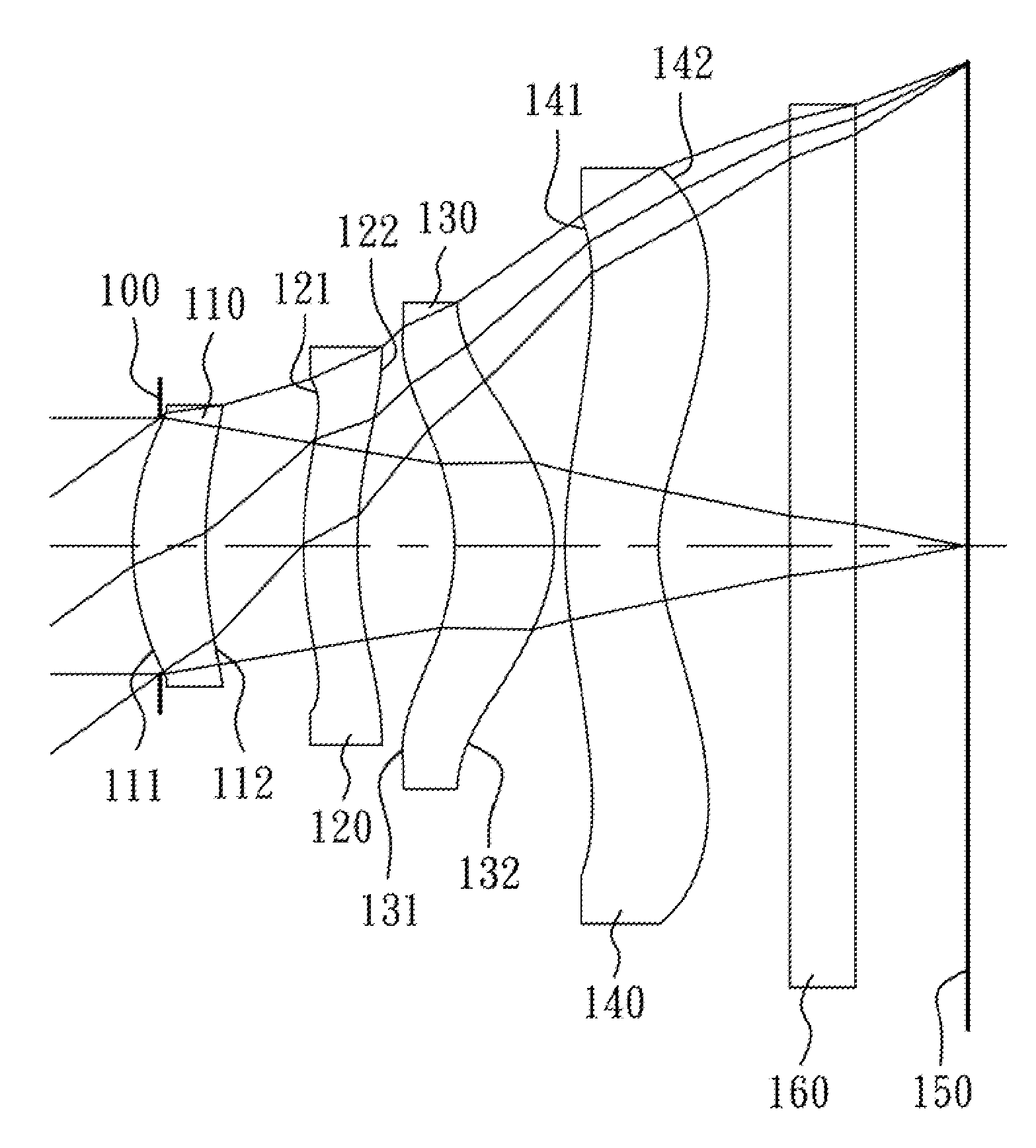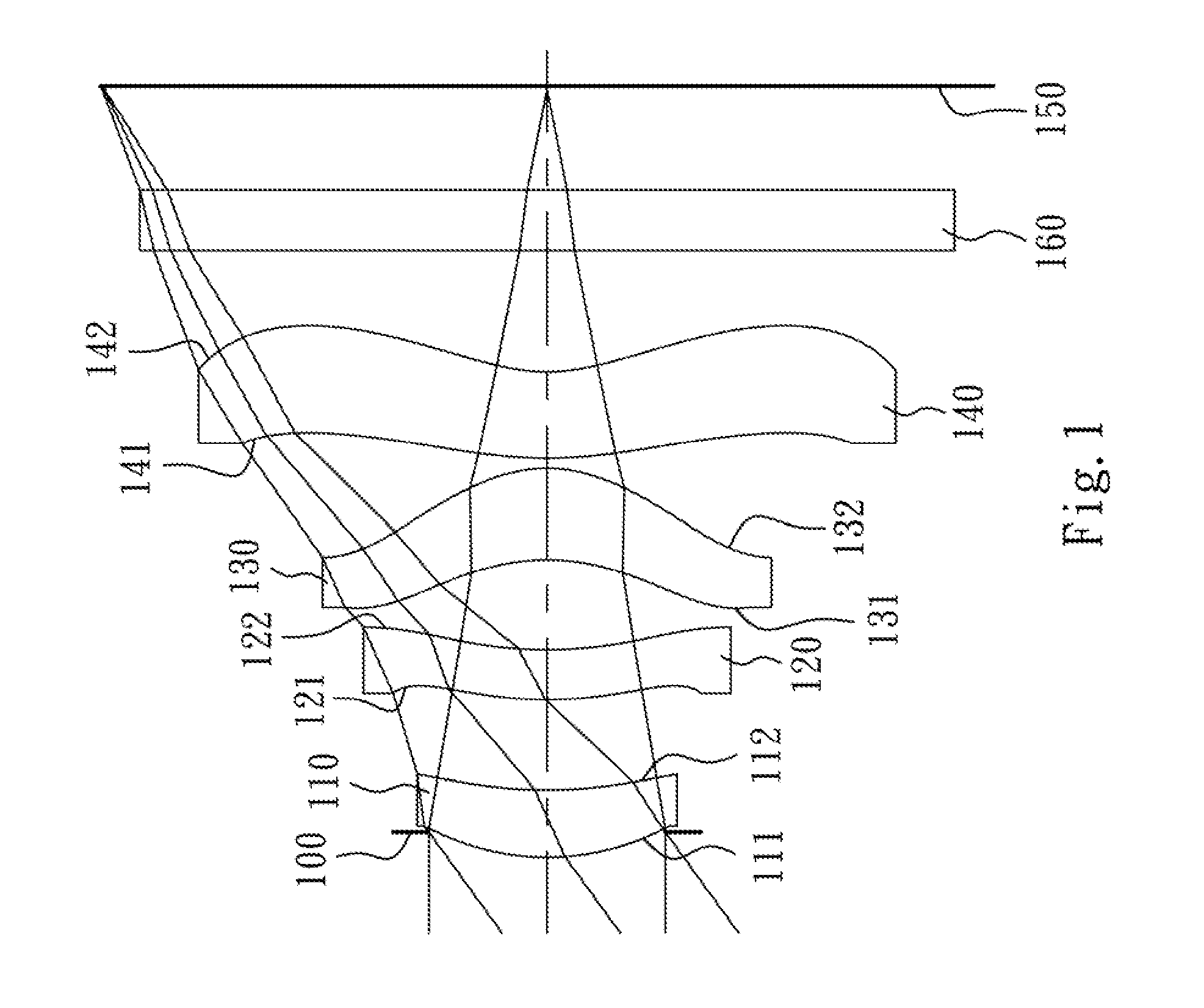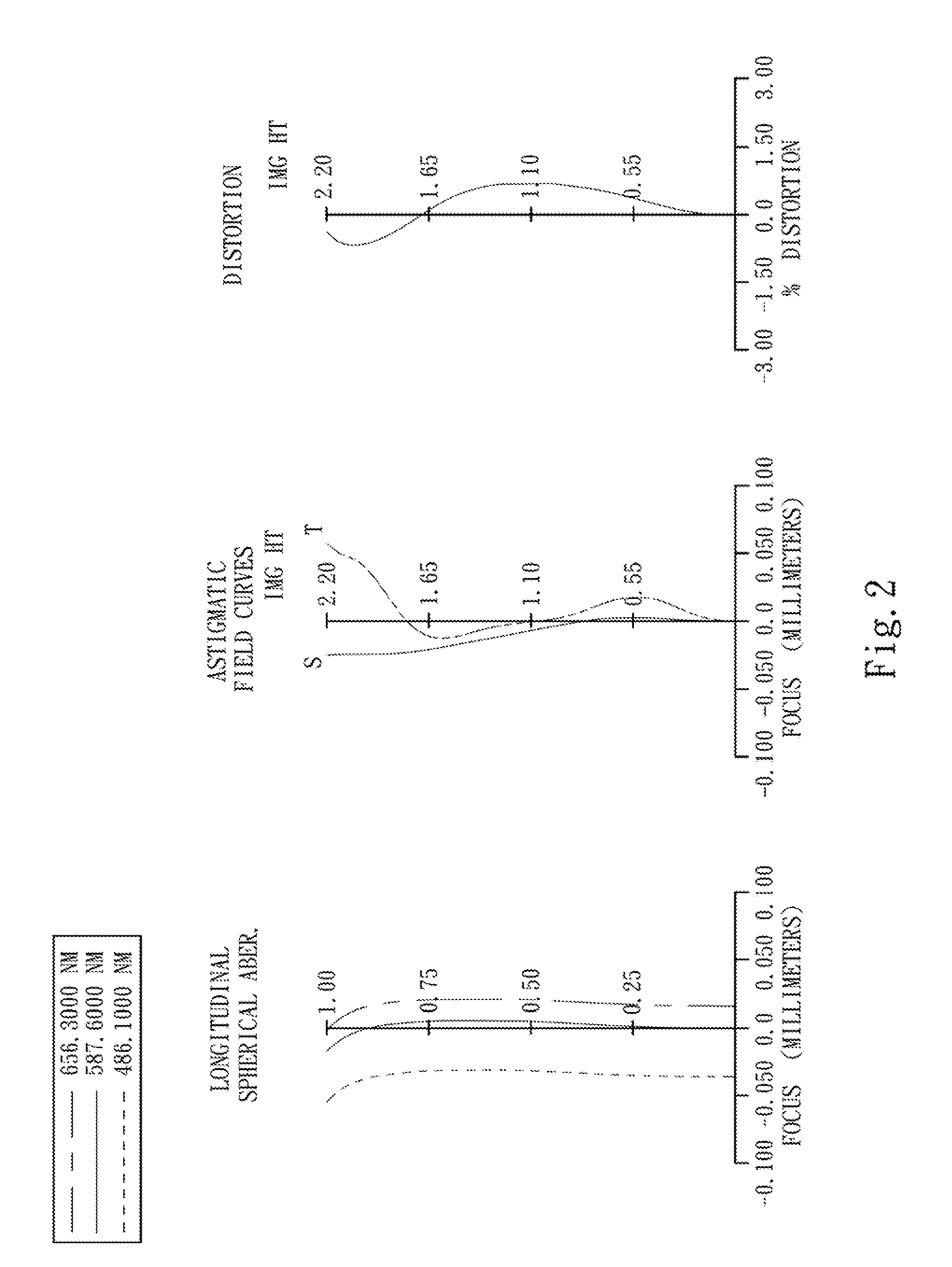Optical image lens assembly
- Summary
- Abstract
- Description
- Claims
- Application Information
AI Technical Summary
Benefits of technology
Problems solved by technology
Method used
Image
Examples
first embodiment
[0055]The equation of the aspheric surface profiles of the aforementioned lens elements of the first embodiment is expressed as follows:
X(Y)=(Y2 / R)(1+sqrt(1-(1+k)×(Y / R)2))+∑i(Ai)×(Yi)
[0056]where:
[0057]X is the height of a point on the aspheric surface spaced at a distance Y from the optical axis relative to the tangential plane at the aspheric surface vertex;
[0058]Y is the distance from the point on the curve of the aspheric surface to the optical axis;
[0059]R is the curvature radius of the lens elements;
[0060]k is the conic coefficient; and
[0061]Ai is the i-th aspheric coefficient.
[0062]In the optical image lens assembly according to the first embodiment, when a focal length of the optical image lens assembly is f, an f-number of the optical image lens assembly is Fno, and a half of the maximal field of view is HFOV, these parameters have the following values:
[0063]f=3.04 mm;
[0064]Fno=2.60; and
[0065]HFOV=36.0 degrees.
[0066]In the optical image lens assembly according to the first e...
second embodiment
[0078]The detailed optical data of the second embodiment are shown in Table 3 and the aspheric surface data are shown in Table 4 below.
TABLE 32nd Embodimentf = 2.97 mm, Fno = 2.60, HFOV = 36.8 deg.FocalSurface #Curvature RadiusThicknessMaterialIndexAbbe #length0ObjectPlanoInfinity1Ape.Plano−0.116 Stop2Lens 11.242830 (ASP)0.339Plastic1.54455.93.6033.073100 (ASP)0.4044Lens 24.262600 (ASP)0.234Plastic1.54455.9−10.6252.405560 (ASP)0.3946Lens 3−2.567550 (ASP) 0.574Plastic1.53055.81.137−0.522300 (ASP) 0.0408Lens 41.899700 (ASP)0.241Plastic1.53055.8−1.1890.449280 (ASP)0.70010IR-filterPlano0.300Glass1.51664.1—11Plano0.44112ImagePlano—Note:Reference wavelength (d-line) is 587.6 nm.
TABLE 4Aspheric CoefficientsSurface #2345k =−4.64729E−01−1.00000E+00−1.00000E+00−1.00000E+00A4 =2.46820E−02−5.11805E−02−4.18851E−01−2.47124E−01A6 =−3.35304E−02−1.23657E−01−1.06690E−01−7.20515E−02A8 =1.57375E−013.70396E−02−2.38094E−015.74152E−02A10 =−4.52684E−01−2.30579E−01−3.20555E−01−3.36773E−02A12 =−8.64164E−02−7...
third embodiment
[0086]The detailed optical data of the third embodiment are shown in Table 5 and the aspheric surface data are shown in Table 6 below.
TABLE 53rd Embodimentf = 2.76 mm, Fno = 2.55, HFOV = 38.7 deg.FocalSurface #Curvature RadiusThicknessMaterialIndexAbbe #length0ObjectPlanoInfinity1Lens 11.567930 (ASP)0.373Plastic1.54455.93.7026.515300 (ASP)0.0563Ape.Plano0.354Stop4Lens 2−11.428600 (ASP) 0.234Plastic1.54455.9−10.51511.525600 (ASP) 0.3756Lens 3−2.532820 (ASP) 0.607Plastic1.53055.81.247−0.566580 (ASP) 0.0408Lens 41.848200 (ASP)0.308Plastic1.53055.8−1.3990.496120 (ASP)0.70010IR-filterPlano0.300Glass1.51664.1—11Plano0.40412ImagePlano—Note:Reference wavelength (d-line) is 587.6 nm
TABLE 6Aspheric CoefficientsSurface #1245k =−7.63492E−01−1.46434E+00−3.00000E+015.00000E+00A4 =7.98798E−03−7.59297E−02−3.86819E−01−2.33277E−01A6 =−7.55745E−02−1.26615E−01−1.35412E−01−1.02237E−01A8 =1.05777E−01−2.20569E−01−2.73986E−01−4.53402E−02A10 =−3.58552E−014.32973E−01−4.50391E−01−1.38267E−01A12 =−5.77891E−02−...
PUM
 Login to View More
Login to View More Abstract
Description
Claims
Application Information
 Login to View More
Login to View More - R&D
- Intellectual Property
- Life Sciences
- Materials
- Tech Scout
- Unparalleled Data Quality
- Higher Quality Content
- 60% Fewer Hallucinations
Browse by: Latest US Patents, China's latest patents, Technical Efficacy Thesaurus, Application Domain, Technology Topic, Popular Technical Reports.
© 2025 PatSnap. All rights reserved.Legal|Privacy policy|Modern Slavery Act Transparency Statement|Sitemap|About US| Contact US: help@patsnap.com



